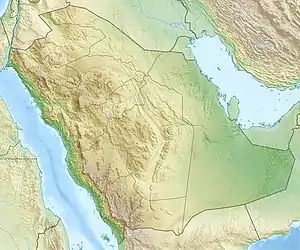Jawatha Mosque
Jawatha Mosque (Arabic: مَسْجِد جَوَاثَا, romanized: Masjid Jawāthā), also incorrectly spelled Al-Jawan, is located in the Jawāthā, about 12 km (7.5 mi) northeast of Hofuf, Al-Ahsa, Saudi Arabia. It was the earliest known mosque built in eastern Arabia, and most of the original structure is in ruins.[2] Nevertheless, the site is still used for prayer.[3]
| Jawatha Mosque | |
|---|---|
مَسْجِد جَوَاثَا | |
 | |
| Religion | |
| Affiliation | Sunni Islam |
| Location | |
| Location | Al-Ahsa, Eastern Province, Saudi Arabia |
 Shown within Saudi Arabia | |
| Geographic coordinates | 25°28′11″N 49°40′43″E |
| Architecture | |
| Type | Mosque |
| Date established | 7[1]–16 AH (c. 629–636[2] CE) |
Construction
Sources give the date of the mosque's original construction as either 628 CE (7 AH)[4][1] or 635-636 CE.[2][4][5] It was built at the hands of the Bani Abd al-Qays tribe, which lived there before and during the early Islamic period.[1][4] This mosque is believed to be the first mosque built in Eastern Province and where the second Friday congregation prayer in Islam was offered, the first being held in the Prophet's Mosque in Medina.[1][4] According to legend, when the Hajr Al-Aswad (Black Stone) was stolen from Mecca by the Qarmatians, it was kept in this mosque for nearly 22 years.[6]
Most of the mosque's original structure has been lost and it remains in danger of collapse. Only a small number of its arches from the historic mosque today, probably dating from around the 9th century AD.[5][4] These remains include two pointed keel arches from one arcade of the mosque and a part of the qibla wall consisting of three keel-arch niches. The central niche of the qibla wall is larger than the other two and acts as the mihrab, which projects from the outer side of the wall.[7] In modern times, sometime before 1983, these remains were cleared of sand and enclosed by a structure of concrete walls and covered with a protective roof, which remains today.[7][4]
References
- Abdul-Ali (August 24, 2005), Jawatha Mosque in danger of going down, Al-Ahsa: Jafariya News
- Roger Wood (1975). An introduction to Saudi Arabian antiquities. p. 151. Retrieved 18 October 2010.
{{cite book}}:|work=ignored (help) - John, Lawton (November–December 1991), The Arab Heartland, vol. 42, Saudi Aramco World, archived from the original on 2012-10-04, retrieved 2010-10-18
- Zami, M. Sharif (2014). "Conservation of architectural heritage in Saudi Arabia: The case study of Jawatha Mosque". In Correia, Mariana; Carlos, Gilberto; Rocha, Sandra (eds.). Vernacular Heritage and Earthen Architecture: Contributions for Sustainable Development (Proceedings of CIAV 2013). CRC Press. pp. 189–193. ISBN 9781138000834.
- Peterson, J. E. (2020). Historical Dictionary of Saudi Arabia. Rowman & Littlefield. pp. xxvi, 35. ISBN 978-1-5381-1980-8.
- "Day trips; Hofuf". Camels. Archived from the original on October 27, 2009. Retrieved 2006-03-06.
{{cite web}}: CS1 maint: unfit URL (link) - King, Geoffrey R. D. (1986). The historical mosques of Saudi Arabia. Longman. pp. 168–169. ISBN 0582783925.
